The Miniature Rooms of Narcissa Niblack Thorne
The Thorne miniature rooms are the brainchild of Narcissa Thorne, who crafted them between 1932 and 1940 on a 1:12 scale. Incredibly detailed and...
Maya M. Tola 27 May 2024
The Mughal Empire stands as one of history’s most opulent periods known to nurture a rich tapestry of art and architecture that offers a glimpse into the unimaginable wealth of that era. Among the many treasures of the Mughal rulers, the wine cups of Jahangir hold a particular fascination. While originally fashioned for practical use, today these vessels are intriguing artifacts from a bygone era.
Exquisite and ornately decorated, the wine cups not only showcase the exceptional craftsmanship of the Mughal artisans but also serve as a poignant reminder of a more universal aspect of the human condition: addiction. Jahangir, the illustrious Mughal emperor, grappled with addiction throughout much of his life. Subsequently these cups are symbols not only of artistic mastery, but also of the complexities and vulnerabilities of powerful figures from history.
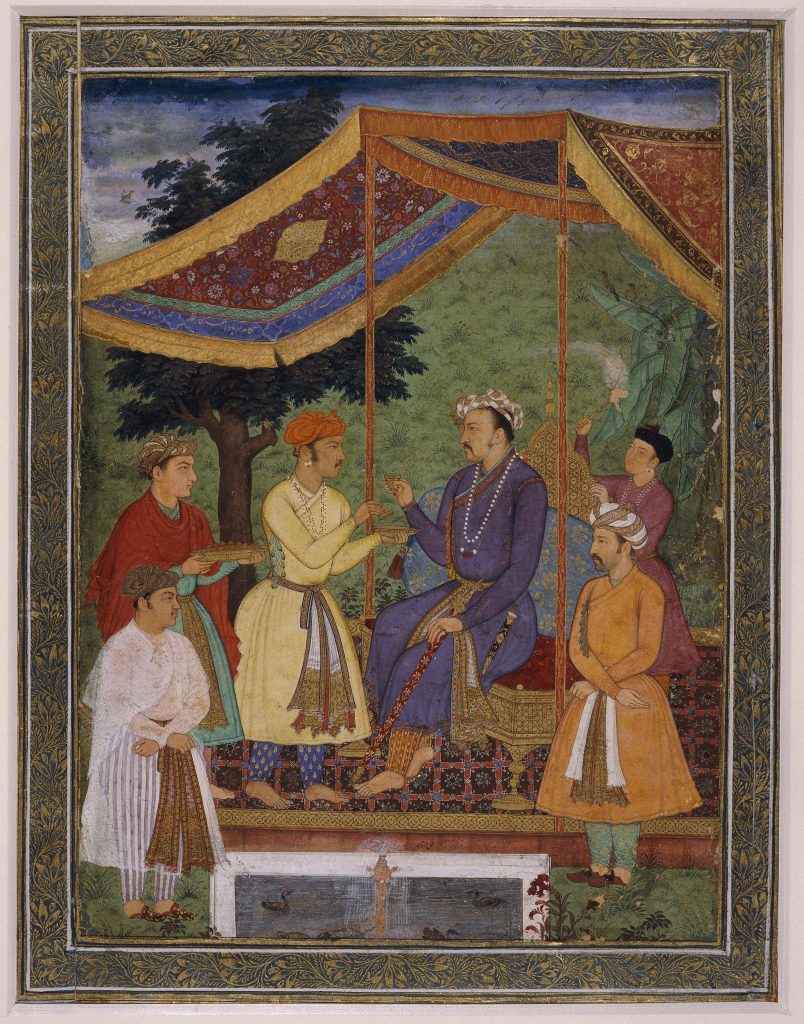
Manohar of Mewar, Portrait of Emperor Jahangir with his sons Khusraw and Parviz, ca. 1610, The British Museum, London,
Jahangir’s life indeed marked a notable departure from his father, the visionary Akbar the Great, who was renowned for his administrative reforms and religious tolerance. In contrast, Jahangir embraced a more indulgent lifestyle, which may have contributed to his self-destructive addictions to opium and alcohol.
Jahangir’s tumultuous journey with addiction was documented in his autobiography, the Jahangirnama. In it he writes that he took his first sip of alcohol at the age of 18. By the age of 27, he was a hopeless addict and needed a servant to hold his cup up to his lips because his hands trembled so much. Eventually, the royal physician intervened and he cut down his consumption significantly but never managed to quit, instead supplementing his intoxication with opium.
Despite the prevalence of alcohol consumption among the elite during that era, Jahangir’s excessive intake had severe consequences, affecting both his political decisions and personal life. His erratic behavior and impulsive choices earned him a reputation for unpredictability, adding complexities to the governance of the Mughal empire.
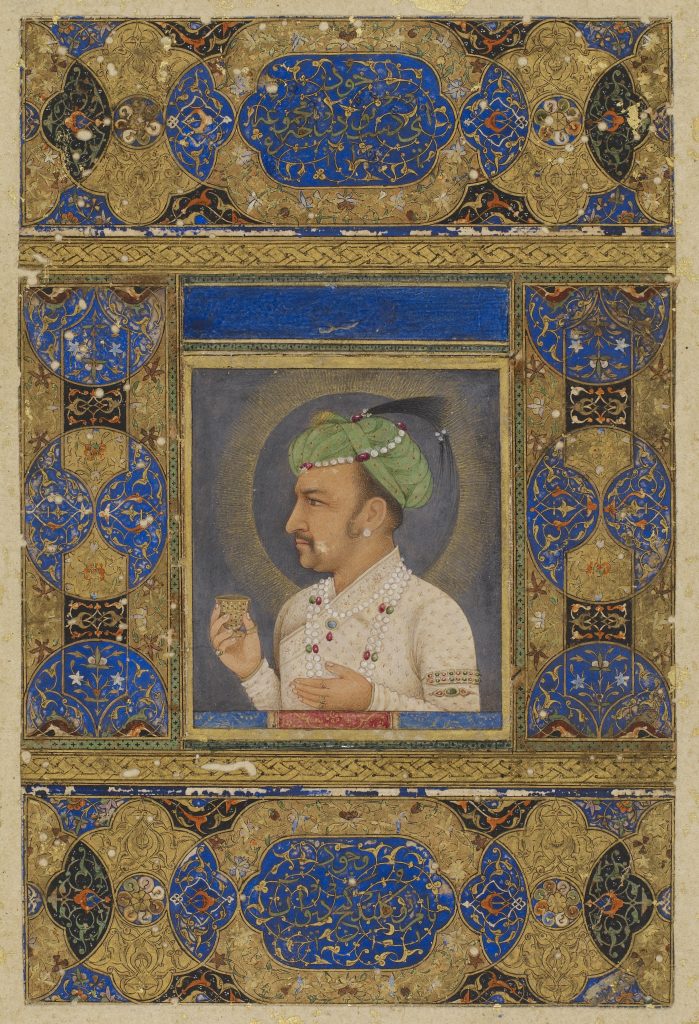
Jahangir with a Wine Cup, Freer Gallery of Art, National Museum of Asian Art at the Smithsonian, Washington, DC, USA.
Overshadowing her husband’s struggles, Empress Nur Jahan displayed remarkable finesse and wisdom as a regent, effectively governing the empire on his behalf. History acknowledges her pivotal role in maintaining and furthering the stability of the expansive Mughal regime during the precarious period of Jahangir’s reign. Nur Jahan’s political acumen and strategic decisions thus played a significant part in securing the empire’s prosperity during such challenging times.
Beyond her political duties, Nur Jahan’s influence extended to the realm of arts and culture. As a patron of the arts, she nurtured a flourishing cultural landscape at the Mughal court, fostering the talents of artists, poets, and musicians. Her support contributed to the zenith of artistic expression during her time, leaving a lasting impact on both the Mughal court and the cultural heritage of the empire.
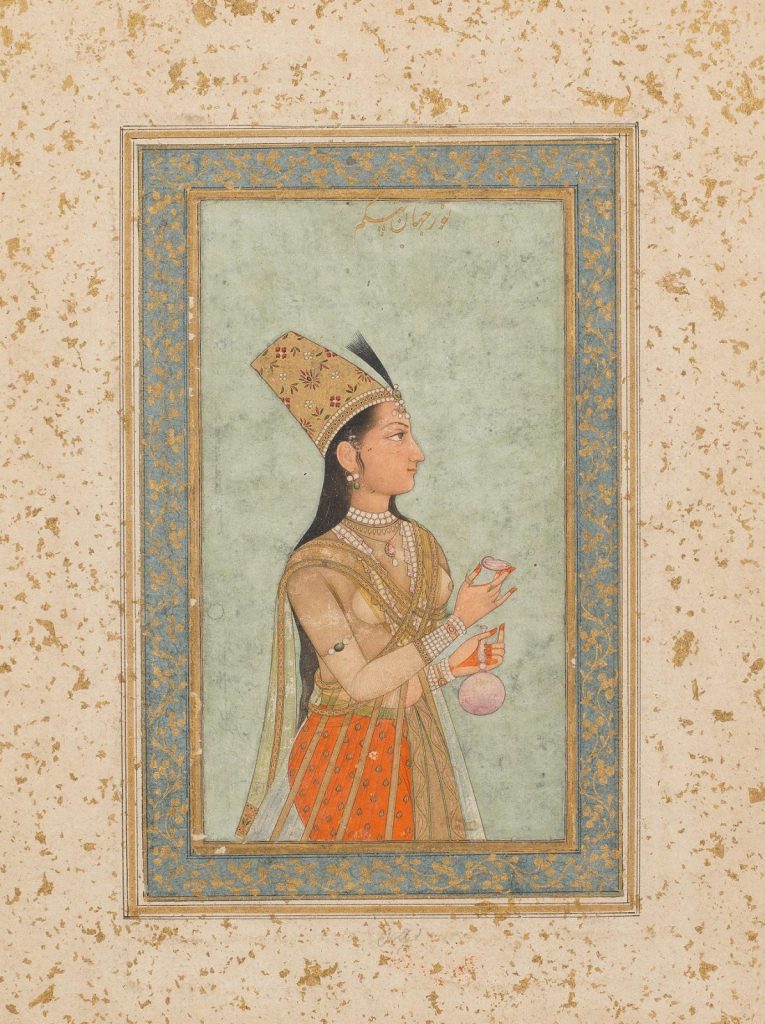
Nur Jahan Begum, wife of the Mughal Emperor Jahangir, holding a bottle and a wine cup, ca. late 17th and 18th century, private collection. Bonhams.
Although banned by Quranic laws, the consumption of alcohol was a cultural phenomenon that held a prominent place in the Indo-Persian courtly culture. The Mughals even embraced it and regarded it as a symbol of refinement among the elite of that era. Nobles, including Jahangir, favored the drink for both its intoxicating quality and its role as a stimulant for intellectual and artistic pursuits.
The painters of the royal atelier, being part of the inner court circle, were likely first-hand witnesses to Jahangir’s excessive consumption and eventual struggle with addiction. We see evidence of Jehangir’s drinking in numerous paintings and engraved coins where he is shown with a cup of wine in hand. Through their artworks, these artists demonstrated their creative prowess by subtly capturing the essence of the melancholy. They skillfully conveyed Jahangir’s emotional state, offering a poignant glimpse into his private struggle.
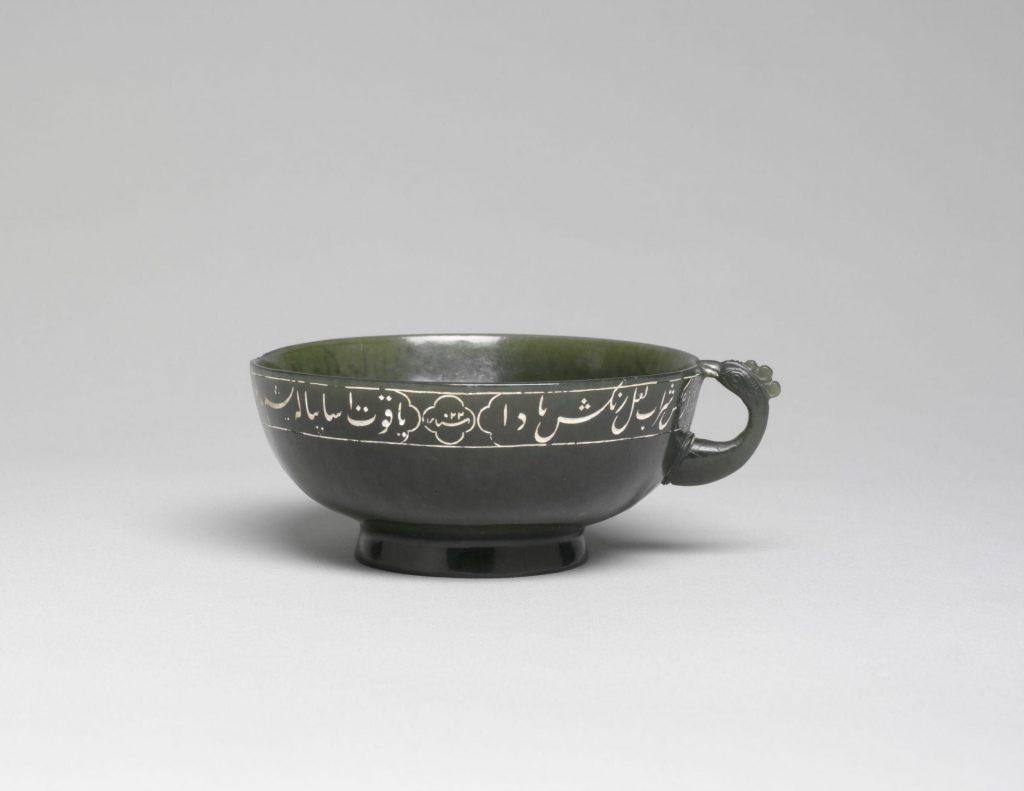
Sa’ida-ye Gilani, Wine cup of Emperor Jahangir, ca. 1613, Victoria and Albert Museum, London, UK.
The wine cups commissioned by Jahangir exemplify the extraordinary craftsmanship and unmatched sophistication of the Mughal atelier. These vessels are nothing short of masterpieces, skillfully crafted using a variety of cut rocks such as jade. Furthermore, precious and semi-precious gemstones adorn the surfaces testifying to the opulence of the era. Jade was extremely rare at the time and was sourced from present-day Xinjiang, China. It was therefore associated with luxury and used to make dagger and sword hilts, or vessels.
The meticulous attention to detail and refined engraving techniques demonstrate the artisans’ commitment to achieving impeccable quality in their intricate designs. These cups feature advanced Persian and Indian designs that characterize what became the quintessential Mughal aesthetic.
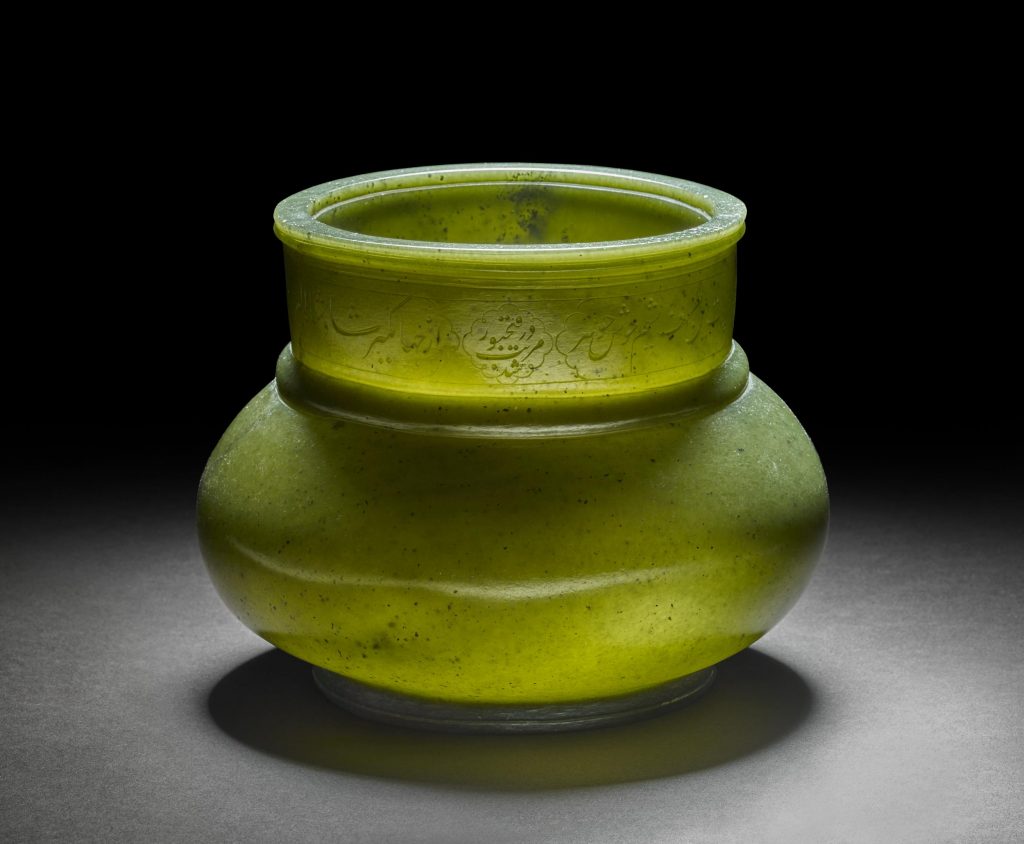
Dark green nephrite wine cup. ca. 1618 to 1619, British Museum, London, UK.
The wine cups Jahangir commissioned served as powerful mediums for conveying symbolism and iconography and were often inscribed with poetry or monograms. The carvings and designs incorporated into these vessels reflects not only the emperor’s personality but also the prevailing philosophical inclinations of the time.
One of the prominent motifs found on these cups is depictions of grapevines, symbolizing abundance and fertility. This choice of symbolism ties directly to the significance of wine itself, representing prosperity and the regenerative powers of nature.
Inscriptions in Farsi and Arabic calligraphy adorn the cups, adding an additional layer of meaning and cultural richness. These inscriptions sometimes include poetic verses composed by Jahangir himself, showcasing his literary talent and intellectual pursuits.
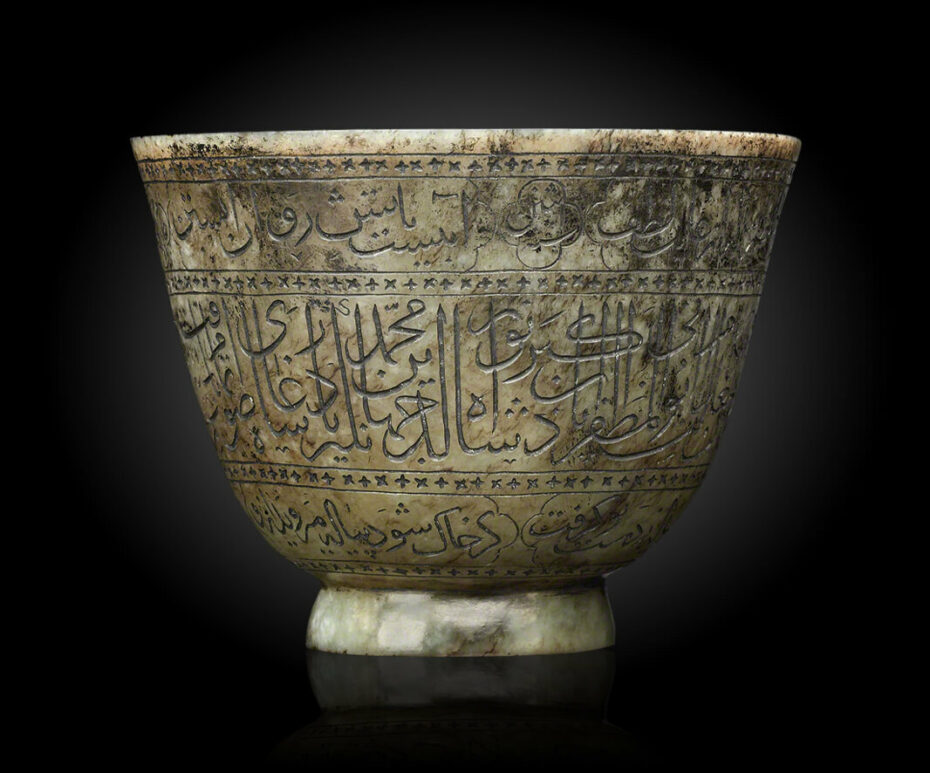
Jade Wine Cup of Mughal Emperor Jahangir, ca. 1607 to 1608, Al Thani Collection, Doha, Qatar.
Artistic production in the Indian subcontinent indeed reached its pinnacle during the opulent reign of the Mughal emperors. Their well-funded royal ateliers were thus centers of exceptional craftsmanship. The wine cups offer a unique window into a time when art and indulgence coexisted harmoniously, exemplifying the opulence and cultural richness of the Mughal court.
Jahangir’s wine cups not only exemplify the grandeur of Mughal craftsmanship during his era but also represent a legacy that extends far beyond his reign. These exquisite vessels, with their intricate carvings and profound symbolism, provide a glimpse into a bygone era of splendor and refinement where seemingly unremarkable utilitarian items were elevated to grand works of art. The juxtaposition of their beauty with the emperor’s personal struggle adds a layer of depth to these artifacts, offering a glimpse into the intricate and sometimes tumultuous lives of those who once held them.
DailyArt Magazine needs your support. Every contribution, however big or small, is very valuable for our future. Thanks to it, we will be able to sustain and grow the Magazine. Thank you for your help!